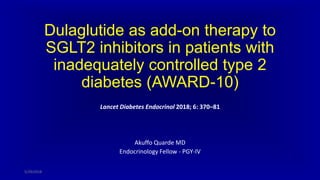Award 10 study presentation
- 1. Dulaglutide as add-on therapy to SGLT2 inhibitors in patients with inadequately controlled type 2 diabetes (AWARD-10) Lancet Diabetes Endocrinol 2018; 6: 370–81 Akuffo Quarde MD Endocrinology Fellow - PGY-IV 5/29/2018
- 2. INTRODUCTION ? GLP-1 receptor agonists and SGLT2 inhibitors lower plasma glucose concentrations, reduce bodyweight, and bring about other clinically relevant outcomes. ? GLP-1 receptor agonists : enhance insulin secretion in a glucose- dependent manner, inhibit glucagon secretion,slow gastric emptying, (especially with short-acting drugs), and suppress appetite ? SGLT2 inhibitors promotes urinary glucose excretion and indirectly increases glucagon concentration ? Investigate the stepwise initiation of GLP-1 receptor agonist in patients on stable SGLT-2
- 3. METHODS ? Study design : 24-week, randomised, phase 3b, double-blind, parallel-arm, placebo-controlled superiority study done at 40 clinical sites in Austria, Czech Republic, Germany, Hungary, Israel, Mexico, Spain, and the USA. ? Inclusion Criteria: Age > 18, A1C 7.0- 9.5, SGLT-2 +/- Metformin ? Exclusion Criteria: T1DM, other OHAs within 3 months of study entry ? Randomization: Randomly assigned (1:1:1) to subcutaneous injection of dulaglutide 1?5 mg, dulaglutide 0?75 mg or placebo (all once weekly) ? Run-in: A dose stabilisation period of up to 12 weeks between screening and randomisation was permitted to allow dose adjustments of SGLT2 inhibitors, metformin
- 4. METHODS ? Outcomes ? Primary outcome -- Dulaglutide relative to placebo for change in HbA1c c concentration from baseline to 24 weeks ? Secondary outcomes -- percentage of patients achieving an HbA1c target concentration of less than 7?0% , change from baseline in bodyweight, and change from baseline in fasting serum glucose concentration ? Sample Size Determination – 120 subjects per group ? 90% power to detect superiority of dulaglutide 1?5 mg or 0?75 mg versus placebo ? a difference between dulaglutide and placebo of 0?55% ? two-sided significance level of 0?025 ? 15% dropout rate
- 5. METHOD
- 7. RESULTS
- 8. COMPOSITE 6 PT SMPG
- 9. CONCLUSION ? Once-weekly dulaglutide 1.5 mg as add-on treatment to SGLT2 inhibitors with or without metformin resulted in superior glycemic control, weight loss, reduction in systolic blood pressure, and acceptable tolerability, consistent with the established safety profile of dulaglutide. ? This combination treatment regimen might be an effective option for the treatment of type 2 diabetes in patients with inadequate glycaemic control.
- 10. Internal Validity – randomized, placebo-controlled, sample size estimation, adjustment for baseline characteristics, intention to treat, CONSORT diagram External Validity – limited to patients with A1C <9.5 on SGLT-2 +/- Met, limited duration of follow up, lack of hard endpoints, real world use in patients with multiple comorbidities precluding the use of GLP-1s, SGLT-2 or metformin. Who sponsored this study? --- Eli Lilly and Company. ? The funder of the study was involved in study design, data collection, data review, data analysis, data interpretation, and writing of the report. ? All authors had full access to all the data in the study. BL and JPF had final responsibility for the decision to submit for publication










